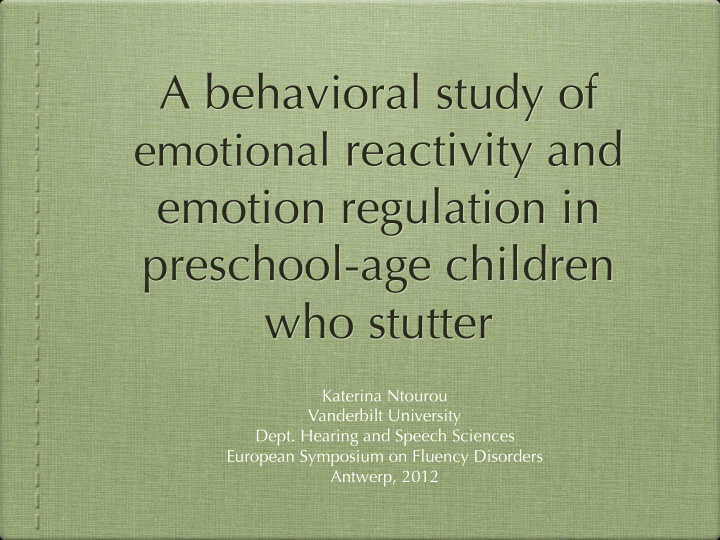



A behavioral study of emotional reactivity and emotion regulation in preschool-age children who stutter Katerina Ntourou Vanderbilt University Dept. Hearing and Speech Sciences European Symposium on Fluency Disorders Antwerp, 2012
Purpose The purpose of this study was to experimentally assess emotional reactivity whether emotional reactivity and emotion regulation differ emotion regulation between preschool-age children who do ( CWS ) and do not ( CWNS ) stutter and whether such emotional processes impact these children ’ s speech disfluencies /stuttering.
Emotional reactivity refers to an individual’s threshold and intensity of emotional arousal in response to internal and/or external stimuli. Emotion regulation refers to the control and modification of emotional arousal
* CWS are less adaptable to change, more emotionally reactive, and more negative in quality of mood than CWNS (Anderson, Pellowski, Conture, & Kelly, 2003; Eggers de Nil, & van den Bergh, 2010; Karrass et al., 2006; cf. Lewis & Goldberg, 1997) * CWS are significantly more reactive to environmental stimuli and less able to quickly habituate to them (Schwenk, Conture, & Walden, 2007) * CWS exhibit more negative emotional expressions than CWNS when receiving a disappointing gift (Johnson, Walden, Conture, & Karrass, 2010) * CWS who use regulatory strategies less frequently and for shorter durations are more apt to exhibit increased stuttering-like disfluencies (Arnold, Conture, Key & Walden, 2011; Walden et al., 2011)
1. Do CWNS and CWS significantly differ in the amount of exhibited emotional reactivity (i.e., positive and negative affect) and emotion regulation (i.e., self- speech and off-task) behaviors during a neutral (control) and a frustrating (experimental) task? 2. Do CWNS exhibit greater increase in negative affect and emotion regulation behaviors, and greater decrease in positive affect during the frustrating than the neutral task? 3. Is there a relation between emotional processes (emotional reactivity and emotion regulation) exhibited during the tasks and the frequency of stuttering- like (SLDs) and non-stuttering-like, or other disfluencies (ODs) produced in subsequent narratives for CWS and CWNS? 4. Do CWS, when compared to CWNS, exhibit greater increase in the frequency of SLDs and ODs during the narrative following the frustrating task than during the narrative following the neutral task.
• 18 ¡CWS ¡(4 ♀ , ¡14 ♂ ) ¡and ¡18 ¡CWNS ¡(4 ♀ , ¡14 ♂ ) ¡between ¡3;0 ¡– ¡5;11 ¡ years ¡of ¡age ¡(CWS: ¡ M ¡= ¡51.67, ¡ SD ¡= ¡9.71; ¡CWNS, ¡ M ¡= ¡53.61, ¡ SD ¡= ¡9.49) ¡ • ParEcipants ¡completed ¡a ¡control ¡and ¡an ¡experimental ¡condiEon ¡in ¡an ¡ counterbalanced ¡order. ¡Each ¡condiEon ¡started ¡with ¡a ¡3-‑min ¡emoEon ¡ manipulaEon ¡task ¡followed ¡by ¡a ¡narraEve. ¡At ¡the ¡beginning ¡of ¡the ¡ session, ¡parEcipants ¡were ¡presented ¡with ¡six ¡giSs/prizes ¡and ¡were ¡ asked ¡to ¡select ¡their ¡favorite ¡one. ¡The ¡selected ¡giS ¡was ¡locked ¡in ¡a ¡ transparent ¡box. ¡ ¡ ¡
Emotional Reactivity during each of the emotion-eliciting tasks: * Duration of Negative Affect / Duration of Task *100 * Duration of Positive Affect / Duration of Task *100 Emotion Regulation during each of the emotion-eliciting tasks: * Duration of Self-Speech / Duration of Task* 100 * Duration of Off-Task / Duration of Task *100 Disfluencies during each of the narratives * Percentage of Stuttering-Like Disfluencies ( SLDs ) * Percentage of Other Disfluencies ( ODs )
No ¡condiEon ¡effect ¡ No ¡talker-‑group ¡effect ¡ No ¡talker-‑group ¡x ¡condiEon ¡interacEon ¡effect ¡
• Condi)on ¡effect: ¡ The ¡experimental ¡manipulaEon ¡was ¡effecEve ¡for ¡both ¡talker-‑groups ¡ • Talker-‑group ¡effect: ¡ CWS ¡exhibited ¡significantly ¡more ¡negaEve ¡affect ¡than ¡CWNS ¡ • No ¡Talker-‑group ¡x ¡Condi)on ¡interac)on : ¡CWS ¡and ¡CWNS ¡responded ¡similarly ¡to ¡the ¡ experimental ¡manipulaEon ¡
• CWS ¡exhibited ¡more ¡self-‑ speech ¡than ¡CWNS ¡only ¡in ¡the ¡ control ¡condiEon ¡ • Only ¡CWNS ¡exhibited ¡a ¡ significant ¡increase ¡in ¡the ¡ amount ¡of ¡self-‑speech ¡ produced ¡from ¡the ¡control ¡to ¡ the ¡experimental ¡condiEon ¡
• For CWS proclivity to Self-Speech during the control and experimental tasks was associated with greater percentage of Stuttering during the narrative tasks, est. β = .04, p = .05. • For CWS greater duration of Off-Task behaviors during the tasks was negatively related to the percentage of Stuttering during the subsequent narratives, est. β = -.04, p = .03.
* Emotional Reactivity: Finding that CWS were more emotionally reactive and exhibited more negative emotional behaviors than CWNS is consistent with previous results based on parent-report questionnaires and behavioral observations. * Emotion Regulation: Contrary to previous research and initial hypotheses, CWS exhibited more self-speech . This increase in CWS ’ s self-speech appeared to be ineffective in decreasing emotional reactivity.
* Self-Speech: The more CWS engaged in self-speech during the tasks, the more they stuttered during the narratives tasks. This relation might be: * Mediated by heightened emotional arousal * Attributed to concurrent/competing communicative intents * Off-Task: The more CWS shifted their attention away from the tasks, the less they stuttered during the narratives. This finding might suggest that attention shifting facilitates speech fluency by: * Modulating heightened emotional responses * Diverting attention away from overmonitoring of the ongoing speech act.
katerina.ntourou@vanderbilt.edu ¡
Recommend
More recommend